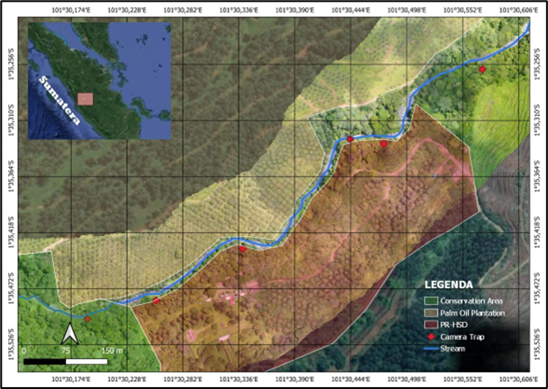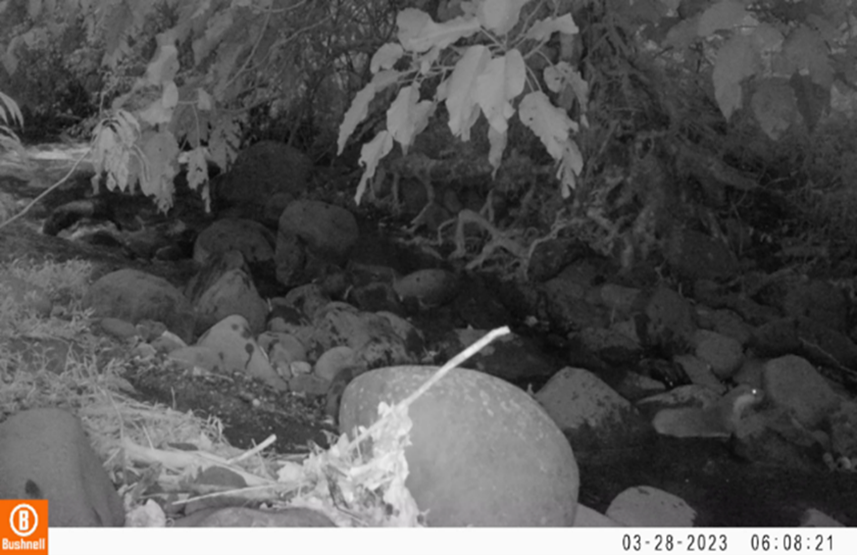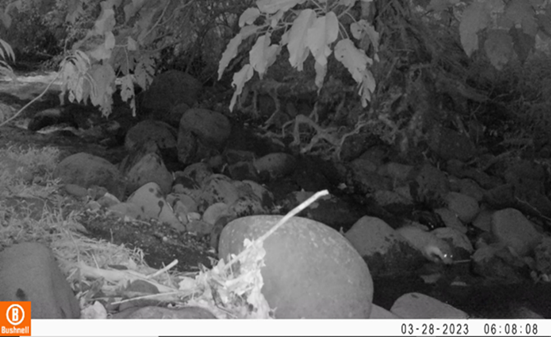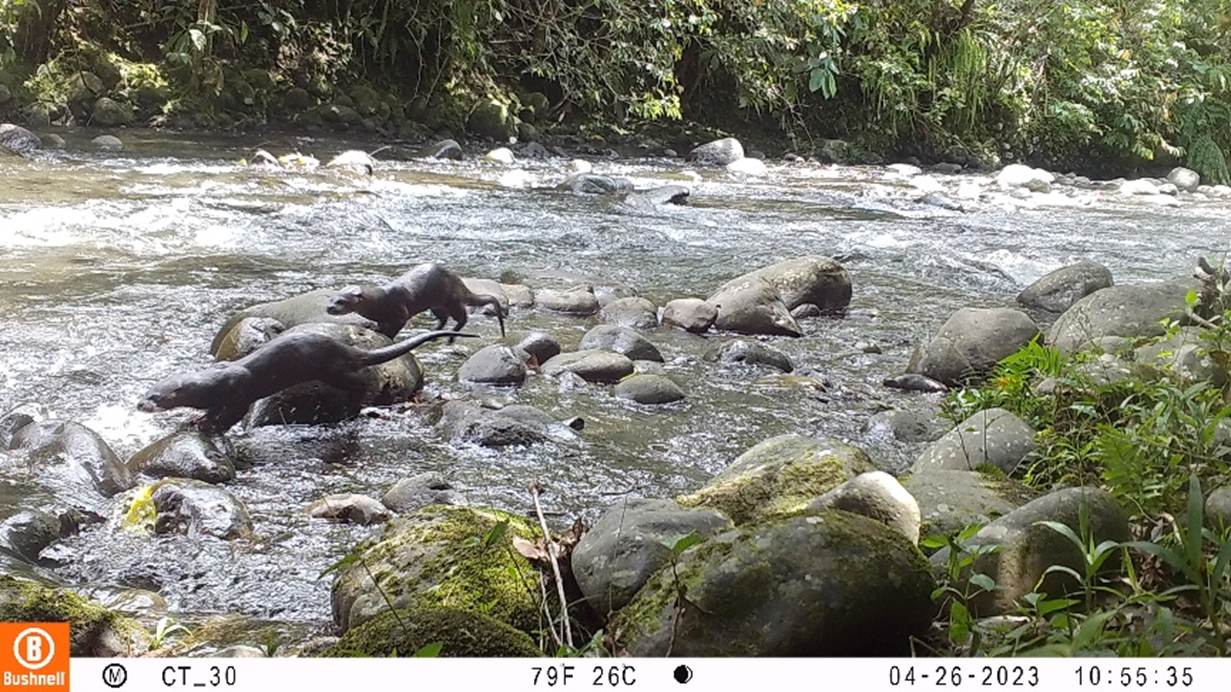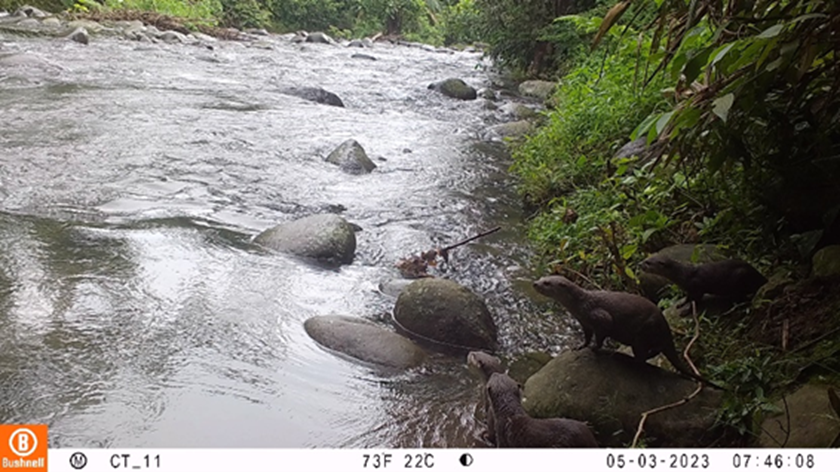IUCN/SSC Otter Specialist Group Bulletin

©IUCN/SCC Otter Specialist Group
Citation: Virdana, S., Andeska, F., Aadrean, Kubontubuh, C.P., Septiansyah, E., Wahyudi, G., and Eveisca, N. (2024). Records of Using the Same Habitat of Three Species of Otters Lutra lutra, Lutra sumatrana and Aonyx cinereus in the Dharmasraya Sumatran Tiger Rehabilitation Centre Area, West Sumatra, Indonesia. IUCN Otter Spec. Group Bull. 41 (2): 64 - 70
Records of Using the Same Habitat of Three Species of Otters Lutra lutra, Lutra sumatrana and Aonyx cinereus in the Dharmasraya Sumatran Tiger Rehabilitation Centre Area, West Sumatra, Indonesia
Sepriyoga Virdana1,3*, Ferdi Andeska2, Aadrean3, Catrini Pratihari Kubontubuh1, Elfira Septiansyah1, Gusra Wahyudi1, and Nadila Eveisca1
1Yayasan Arsari Djojohadikusumo, Jl. Penjernihan II/7 Jakarta 10210, Jl. Veteran I/27 Jakarta 10110, Indonesia
2Berang Berang Indonesia, Indonesia
3Biology Department of Andalas University, West Sumatra, Indonesia
*Corresponding Author Email: sepriyogavirdana@gmail.com
Received 12th August 2023, accepted 17th October 2023
Abstract: The first record of a finding a Lutra lutra in the wild was recorded by a amera trap. Then we report a new
record of the existence of Lutra sumatrana in the central part of the island of Sumatra and a new record in Indonesia
of the existence of three sympatric otter species in one habitat.
Keywords:Mangun River, Camera Trapping, First Record, Oil Palm Plantation
Observation
This observation stems from a report by workers at the Dharmasraya Sumatran Tiger Rehabilitation Centre who saw an animal they believed was an otter. However, they could not identify the type of otter. Based on this information, we conducted a further survey by installing 6 camera traps on a long river stretch for 1 km along the outskirts of the Mangun River (approx 18 meters wide).
The Dharmasraya Sumatran Tiger Rehabilitation Centre (PR-HSD) is located in the 2400 hectare Prof. Sumitro Djojohadikusumo Conservation Forest (AK-PSD), set aside from the 27.000 hectare palm oil plantation site belonging to PT. Tidar Kerinci Agung (TKA), managed under the Cultivation Right (HGU), in Dharmasraya Regency, Nagari Lubuk Besar, Asam Jujuhan District, Dharmasraya Regency, West Sumatra (1o35’30.5” S, 101o30’19.3” E) (Fig. 1). PR-HSD is one of the Arsari Djojohadikusumo Foundation programs which focus on the rescue, rehabilitation, and release activities for sumatran tigers in West Sumatra. PR-HSD and PT. TKA are tied to cooperation under the law that allows PR-HSD to operate within the area.
Our camera trap results found three species of otter: Lutra lutra, Lutra sumatrana and Aonyx cinereus. The location where these were recorded was on the Mangun River, quite close to each other, but at different times of day. The first otter was recorded on March 28, 2023, at 06:08 WIB: an individual Lutra lutra (Fig. 2) looking for food in the Mangun tributary with a video duration of 30 seconds (https://youtu.be/NbnUjlgc9c0).
On April 26, 2023, at 10.55 WIB, we got an image of L. sumatrana at a camera trap location near the L. lutra location, approximately 300 meters downstream. Two individuals were crossing the rocks along the upper reaches of the Mangun River (Fig. 3). Furthermore, we also recorded A. cinereus twice in the same location, looking for food, on April 21, 2023, at 14.48 WIB and on May 1, 2023, at 14.09 WIB.
At a different time, on May 3, 2023, from 7.46 to 7.52 WIB, near the first L. lutra discovery, approximately 50 meters downstream, i.e. close to a part of the river where the water level is rather deep, a group of four Aonyx cinereus otters was seen on the riverbank, and then one individual jumped into the river and swam to find food downstream (Fig. 4).
This discovery is a new published record for information on otter distribution and ecological behavior in Indonesia. The sympatric presence of L. sumatrana, L. lutra and A. cinereus in one habitat is a new finding for the ecological behavior of these three species.
During the survey, we also made observations on the banks of the river, aiming to see other signs of the presence of otters in the Mangun River, such as tracks and scat. On April 4th, we found otter excrement on a rock and collected it. Furthermore, we also found otter droppings on riverbank rocks on April 9 and 12, 2023, at the same location, and this location is just a short distance from where the first excrement was found. The research location is in the Mangun watershed forest, and there is also the oil palm plantation of PT. TKA, but the habitat of this river is still protected from mass fishing using poison.
DISCUSSION
Lutra lutra
In IUCN Red List, Lutra lutra is classified as “Near Threatened” with a declining population (Loy et al, 2022). L. lutra is distributed throughout Europe and Asia, from Ireland in the west to East Russia and China. They are also found in small numbers in North Africa and the Middle East. However, the number and status of L. lutra in many regions, such as Russia and most of Asia, need to be better known (Yoxon and Yoxon, 2019). There have been no recorded sightings of this species since the early 1990s in many countries, such as Indonesia, Cambodia and Vietnam. There are few recent records in Sri Lanka through 2018 (de Silva and Nugegoda, 2018) and Laos in April 2018 (Yoxon, 2018).
This is a new record for the existence of L. lutra in Sumatra today. Previously, confirmation of the existence of L. lutra in Sumatra has been limited to dead animals, findings from trade and reports of pets.
Lutra sumatrana
In the IUCN Red List, Lutra sumatrana is classified as “Endangered”, with decreasing population trend (Sasaki et al, 2021). Peat swamp forests are assumed to be one of the most important habitats, along with seasonally flooded forest, tropical forests, and low land wetland including coastal areas. The Red List report also lists roadkill animals from roads in oil palm plantations. In Sumatra, Lubis (2005) reports L. sumatrana, who had died as a result of being hit by a car, in southern Sumatra. Latifiana and Pickles (2013) reports L. sumatrana in swamps and lagoons dominated by nipa palm in the Tambling Wildlife Reserve, which is located within the Bukit Barisan Selatan National Park in southern Sumatra.
The Red List shows the distribution of L. sumatrana in Sumatra to be limited to the southern part of the country. This report presents the first recent record of this species in the central part of Sumatra (Fig. 5)
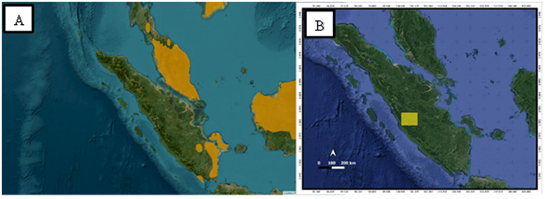
(B) L. sumatrana findings map in this report.
Aonyx cinereus
In the IUCN Red List, Aonyx cinereus is classified as “Vulnerable”, with decreasing population (Wright et al, 2021). It is the most common and widely spread otter to be found in Indonesia, and is the most adaptable to human proximity, using drainage ditches and rice paddies. Of the three otter species considered here, it is the most studied, and its distribution the most well-known (Aadrean et al, 2010; Aadrean et al, 2011; Aadrean and Usio, 2017, 2020; Andeska et al, 2021; Andeska et al, 2023). This is the first record of its presence in the Mangun River.
Sympatry of Otter Species in Sumatra.
It was previously known that L. perspicillata, L. lutra and A. cinereus could coexist sympatrically at the Huai Kha Khaeng Wildlife Sanctuary in Thailand (Kruuk et al. 1994). This is the first record of coexistence of L. lutra, L. sumatrana and A. cinereus in the same habitat in Sumatra.
The evidence of L. lutra and L. sumatrana in the PR-HSD of the Mangun River implies the existence of a population of these two species of otter may have lived in the area for some time. However, current findings of L. lutra in the wild are very limited compared to L. sumatrana (though the latter is considered more endangered: Sasaki et al, 2021) (Fig 6.).
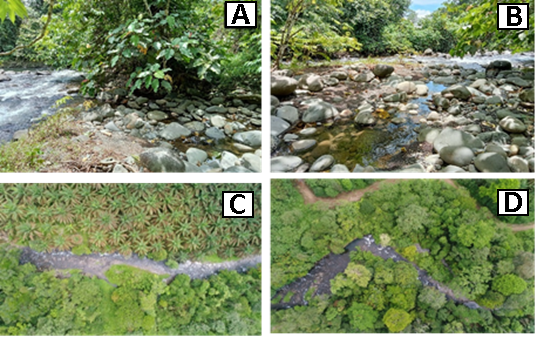
CONCLUSION
This report indicates that that the river ecosystem around AK-PSD can provide a suitable environment for three otter species, one of them Endangered, to survive. We hope that this data will provide valuable baseline information for environmental experts in efforts to preserve and manage river ecosystems in a sustainable manner. It is, therefore, necessary to carry out further research on the otter population around the Mangun river to understand the environmental conditions and how we can maintain the existence of these animals in the future.
Acknowledgements: We are thankful to Yayasan Arsari Djojohadikusumo and PT Tidar Kerinci Agung for supporting the fieldwork and our thanks to member of IUCN Otter Specialist Group for confirming the identification.
REFERENCES
Aadrean, and Usio, N. (2017). Small-clawed otters (Aonyx cinereus) in Indonesian rice fields: latrine site characteristics and visitation frequency. Ecological Research, 32: 899-908 https://doi.org/10.1007/s11284-017-1496-6
Aadrean, and Usio, N. (2020). Spatiotemporal patterns of latrine-site use by small-clawed otters in a heterogeneous rice field landscape. Mammal Study 45: 103–110 https://doi.org/10.3106/ms2019-0031
Aadrean, Novarino, W. and Jabang. (2011). A Record of Small-Clawed Otters (Aonyx cinereus) foraging on an Invasive Pest Species, Golden Apple Snails (Pomacea canaliculata) in a West Sumatra Rice Field. IUCN Otter Spec. Group Bull. 28 (1): 34 - 38 https://www.iucnosgbull.org/Volume28/Aadrean_et_al_2011.html
Aadrean, Salmah, S., Salsabila, A., Rizaldi and Janra, M.N. (2010). Tracks and Other Signs of Otters in Rice Fields in Padang Pariaman, West Sumatra: A Preliminary Study. IUCN Otter Spec. Group Bull. 27 (1): 6 – 11 https://www.iucnosgbull.org/Volume27/Aadrean_et_al_2010.html
Andeska, F., Novarino, W., Nurdin, J. and Aadrean. (2021). Relationship between Temporal Environment Factors and Diet Composition of Small-Clawed Otter (Aonyx cinereus) in Heterogeneous Paddy Fields Landscape in Sumatra, Indonesia. IUCN Otter Spec. Group Bull. 38 (2): 106 - 116 https://www.iucnosgbull.org/Volume38/Andeska_et_al_2021.html
Andeska, F., Novarino, W., Nurdin, J., and Aadrean (2023). An Ecological Study of the Prey of the Otter in an Asynchronous Paddy Field Landscape. IUCN Otter Spec. Group Bull. 40 (2): 96 - 108. https://www.iucnosgbull.org/Volume40/Andeska_et_al_2023.html
de Silva, P.K., and Nugegoda, V, (2018). Otter sighting at Vil Uyana, Sigiriya, Sri Lanka. OTTER, Journal of the International Otter Survival Fund, 4: 36-37. https://www.academia.edu/43307192/OTTER_Journal_of_the_International_OOer_Survival_Fund_Vol_4
Huda, M., Fauzil, A.F., Amran, A.l., Traeholt, C., and Silmi, M. (2019). First record of Hairy-nosed otter (Lutra sumatrna) in southern central Kalimantan, Indonesia IUCN Otter Spec. Group Bull. 36(2): 98-102. https://www.iucnosgbull.org/Volume36/Huda_et_al_2019.html
Kruuk, H., Kanchanasaka, B., O'Sullivian, S., and Wanghongsa, S. (1994). Niche separation in three sympatric otters Lutra perspicillata, Lutra lutra and Aonyx cinerea in Huai Kha Khaeng, Thailand. Biological Conservation, 69: 115-210. https://doi.org/10.1016/0006-3207(94)90334-4
Latifiana, K., and Pickles, R.S.A. (2013). New observation of the Hairy-nosed Otter (Lutra sumatrna) in Sumatra. IUCN Otter Spec. Group Bull. 30(2): 119-123. https://www.iucnosgbull.org/Volume30/Latifiana_Pickles_2013.html
Loy, A., Kranz, A., Oleynikov, A., Roos, A., Savage, M., and Duplaix, N. (2022). Lutra lutra (amended version of 2021 assessment). The IUCN Red List of Threatened Species 2022:e.T12419A218069689. https://dx.doi.org/10.2305/IUCN.UK.20222.RLTS.T12419A218069689.en
Lubis, R. (2005). First Recent Record of Hairy-Nosed Otter in Sumatra, Indonesia. IUCN Otter Spec. Group Bull. 22(1): 14 – 20. https://www.iucnosgbull.org/Volume22/Lubis_2005.html
Sasaki, H., Aadrean, A., Kanchanasaka, B., Reza Lubis, I., and Basak, S. (2021). Lutra sumatrana. The IUCN Red List of Threatened Species 2021: e.T12421A164579488. https://dx.doi.org/10.2305/IUCN.UK.2021-3.RLTS.T12421A164579488.en
Wright, L., de Silva, P.K., Chan, B., Reza Lubis, I., and Basak, S. (2021). Aonyx cinereus. The IUCN Red List of Threatened Species 2021: e.T44166A164580923. https://dx.doi.org/10.2305/IUCN.UK.2021-3.RLTS.T44166A164580923.en
Yoxon, G. (2018). New report of Eurasian otters in Lao. ORYX, The International Journal of Conservation 52 (4): 611–612. https://doi.org/10.1017/S003060531800090X
Yoxon, P., and Yoxon, B. (2019). Eurasian otter: review of current world status. OTTER: Journal of the International Otter Survival Fund 5 : 53-73. https://www.researchgate.net/publication/342122678_OTTER_Journal_of_the_International_Otter_Survival_Fund_Vol_5
Résumé : Enregitrements utilisant le Même Habitat de Trois Espèces de Loutres Lutra Lutra, Lutra Sumatrana et Aonyx Cinereus dans l’aire du Centre de Réhabilitation des Tigres de Dharmasraya Sumatran, Située à l’Ouest de Sumatra dn Indonésie
Le premier relevé de la découverte de Lutra lutra dans la nature a été enregistré par un piège photographique. Nous avons par la suite rapporté une nouvelle observation de l’existence de Lutra sumatrana dans la partie centrale de l’Île de Sumatra et un nouveau constat de coexistence des trois espèces de loutres sympatriques dans un habitat en Indonésie.
Revenez au dessus
Resumen: Registros del uso del Mismo Hábitat por parte de Tres Especies de Nutria Lutra lutra, Lutra sumatrana y Aonyx cinereus en el Área del Centro de Rehabilitación de Tigre de Sumatra Dharmasraya, Sumatra Occidental, Indonesia
El primer registro de una Lutra lutra fue realizado mediante una cámara-trampa. Luego informamos un nuevo registro de la existencia de Lutra sumatrana en la parte central de la isla de Sumatra y un nuevo registro en Indonesia de la existencia de tres especies simpátricas de nutria en un hábitat.
Vuelva a la tapa
Ringkasan: Catatan Penggunaan Habitat yang sama oleh Tiga Spesies Berang-Berang Lutra lutra, Lutra sumatrana dan Aonyx cinereus di Area Pusat Rehabilitasi Harimau Sumatera Dharmasraya, Sumatera Barat, Indonesia
Catatan pertama dari temuan Lutra lutra di alam yang terekam oleh kamera jebak. Selanjutnya kami melaporkan catatan baru keberadaan Lutra sumatrana di pulau Sumatera bagian tengah dan sebuah catatan baru di Indonesia tentang keberadaan tiga spesies berang-berang yang hidup simpatrik dalam satu habitat.
Kembali ke awal

